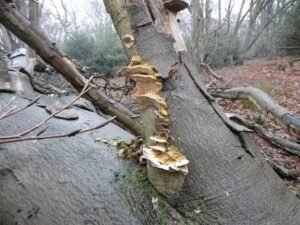On one of my now frequent visits to Epping Forest, I had no intentions of foraging, just out for exercise; However, I just happened to come across quite a lot of tree fungus in Epping forest this time. Both easily identifiable, and (at least for me) unidentifiable.
Birch Polypore
So the first thing I cam across was a dead Birch tree, which had quite a lot of Birch Polypore (Pitptoporus betulinus). Piptoporus comes from the latin meaning ‘pores cast down’ and betulinus from its host tree, the birch.


It’s easy to identify. It’s brown on the top, and white on the bottom. From the name, unlike other mushrooms, it doesn’t have gills on the bottom for spreading its pores, it has lots of tiny holes instead. It’s only found on dead or dying Birch trees, and it erupts directly from the truck in a bracket shape (also a horseshoe shape at one stage in its development).
It turns out that Birch Polypore is an amazing resource when it comes to found food; It is edible, but can be a little bitter, however, it is much more useful as a medicinal item. The Birch Polypore makes an immune tonic which is anti-inflammatory, anti-tumour, anti-parasitic, anti-septic, anti-viral, anti-bacterial, styptic. I’ve written a separate and full article about the health benefits here…
Jew’s Ears
I’ve been keeping an eye out for these for ages now, and not had any luck. They grow on Elder, and my favourite garden plant is our Elder tree. I’ve had plenty of use out of the flowers and berries. Also, on my first guided foraging walk, the instructor showed them and told us all about them. On top of all that, I knew that there were a fair few Elder in and around Epping Forest.
I was actually rushing back to the car, having stayed a little longer than expected, so I apologise for the poor quality of the pictures.

Apparently, the politically correct name for them now is Jelly Ears, but I know them as Jew’s Ears so that’s the name that I’ll be using.
Like the Birch Polypore, this one is quite easy to identify and not easy to confuse with anything else. It has a slightly rubbery, jelly-like texture, and turns in on itself like an ear. It’s a sort of leathery-pink colour (a bit like skin) and as far as I’m aware, it’s mostly found on Elder trees, so that’s a good giveaway.

If you’ve ever eaten Chinese food, there’s a good chance that you’ve eaten these in a meal. They can also be picked, wiped clean and eaten raw. They’re fairly tasteless, and a little chewy, so quite useful as a natural gum to chew on. I’ve done a more in-depth article about them here…
Not so easily identified
On a huge fallen oak, I saw this rather unattractive fungus.

I’ve marked it as Witches Butter, and I think that’s probably correct, but it could be either Exidia Glandulosa (Black Witches’ Butter, Black Jelly Roll, or Warty Jelly Fungus), or possibly Exidia Nigricans (Witches Butter). Either way they’re pretty disgusting looking. Apparently, they are edible similarly to Jew’s Ears in that they absorb flavours quite well in cooking. It could be a while before I give it a try.

This Jelly brain-like fungus on the same fallen oak, is also pretty nasty looking. I found a reference to a Ascotremella faginea, and that seems to match a lot of the pictures that Google has. There doesn’t seem to be too much information on the internet for it, so I’m going to steer well clear!

I suspect that these bracket fungus on an Oak tree were easier to identify a while ago before they started to break down.

There was a small pile of this in the leaves next to the tree. Probably an old Moon poo (yes, that’s really a thing!), but too far gone now to be sure.

Unfortunately, the picture is a little out of focus, and you can’t see the caps of these. All I can really be sure of is that they are not polypores, because I can see the gills! Looking at the tree bark, it could be some kind of Cherry maybe? A varied, maybe Oak leaf litter around the base. Possibly Oyster mushrooms, if so that would be great, but I can’t be sure from the picture. I may have to go back and have another look, or bring one home with me.







